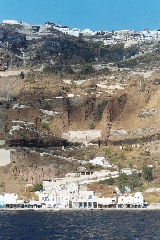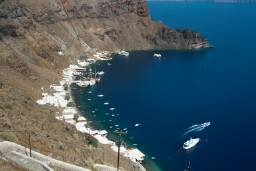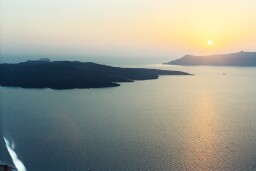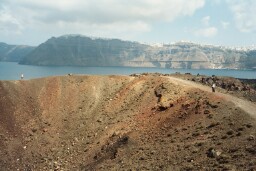1986, 1987, 1990, 1995, 1997,
1999, 2002, 2006, 2008, 2011,
2013 and 2014
Walking, trekking and hiking on SANTORINI and THIRASIA
WALKS
(last update on the 24th of January 2021)
*** = very beautiful
**** = exceptional
1. Akrotíri - Panagía Kímisis - Mésa Pigádia - Lighthouse - Akrotíri
2. Emborió - Pýrgos - Profítis Ilías - Théra - Períssa ***
6. Kamári - Théra - Profítis Ilías - Pýrgos ***
9. Pýrgos - Mésa Goniá and back
10. Pýrgos - Profítis Ilías - Théra - Períssa ***
11. Pýrgos - Vóthonas - Kamári
12. The volcano and Thirasiá ***
13. Thirasiá: Ríva - Agriliá - Christós - Potamós - Manolás - Ríva
14. Vóthonas - Pýrgos - Profítis Ilías - Emborío
Together
with Mýkonos Santoríni is one of the best known, so also one of the most
tourist islands of the Cyclades. While the development of Mýkonos had
already started in the ‘60s, the island of Santoríni (or Thira) remained
relatively sparsely visited until the ’70. This was partly due to the
destructions caused by the severe earthquake of 1956. Because of the
excavations by Spiros Marinatos and the publication of "Atlantis, the
truth behind the legend" by A.G.Galanopoulos and Edward Bacon in
1969, both archaeologists and the larger public became interested again in
Santoríni. But it was only in the ‘80s and ‘90s that the island was
really discovered by mass tourism. This lead, inevitably, to a commercial
invasion of the beautiful towns like Firá and Ia, to the construction of
innumerable houses, hotels and an airport, and to an overpopulation of the
beaches.
However, just like
on the island of Mýkonos, there are still magical places on Santoríni,
even though the island is definitely overcrowded in Summer: truly
wonderful are the narrow streets of Firá, the panoramic views on the
volcano and the caldera - the steep slopes going down to the sea -, the
old stairs of Firá, Thirasiá and Ia, the sunsets, and the archaeological
sites of Théra and Akrotíri.
To get to Santoríni
you can fly with Olympic Airways, but there are also many boat lines from
the Piraeus: one busy boat line with large and fast ships goes from Athens
to Santoríni in 8 hours. These boats pass Páros and Náxos - departure
from Piraeus at 07h30 am, arrival at 15h00 pm. An other connection between Piraeus and Rhódos passes by Mílos,
Santoríni, Crete, Kássos, Kárpathos and Chálki - it is executed 2
times a week by the Prevéli.
There is also a western and slower line, that passes by Kýthnos, Sérifos,
Sífnos and Mílos - twice
/ three times a week, the Agios Geórgios
or the
Adamántios Koraïs
continue to Folégandros,
Síkinos, Ios and Santoríni.
An other interesting line is Sýros - Páros - Náxos - Folégandros - Síkinos
- Ios - Ríva - Santorini - Anáfi (twice a week, on Tuesday and Saturday,
with the Aqua Spirit).
These boats are the successors of the old Panagía Tínou and Panagía
Chozoviótissa...
In summer, there are many faster connections, e.g. by the Superjet (departure
at 07h00 am, arrival at 11h40 am - via Mílos and Folégandros), by the
High Speed V (departure at 07h30 am, arrival at 12h15 pm - via Páros, Náxos
and Ios) and by the High Speed VI (departure at 07h00 am, arrival at 11h25
am - via Ios).
Finally, there is also a boat line that relies Iráklio with Mýkonos, and
that passes by Santoríni and Páros (executed by the
Flying Cat IV
or the Megajet).
All of these boats arrive in the harbour of Athinió and
from there you have to catch a bus or a taxi, preferably to Firá. Indeed,
although the town is busy and the prices are fairly high, it is still
advisable to stay in the old Firá. The town of Ia is much more artificial
and from places inland like Períssa or Akrotíri you cannot enjoy the view
over the volcano, which is an absolute must. To avoid the Summer crowd it
is thus a good idea to visit Santoríni in Spring or Autumn.
Although there is
not really an abundance of hiking trails on Santoríni, there are a couple
of them, and hiking is the ideal way to escape the crowd and the
artificial aspects of the island.
The town of Firá,
with its neighbouring villages Firostefáni and Imerovígli more to the
north, offers a magnificent balcony with panoramic views over the sea and
the volcano. You definitely have to try to also walk around here early in
the morning and, obviously, during sun set. The new prehistoric museum is
really a must. Leaving from the bus square (behind the main church) you
can take buses in every direction: to Ia, Kamári, Períssa (via Pýrgos and
Emborío), Akrotíri, etc. At the Theotokópoulo-square, immediately north of
the bus square, you can find many travel agencies and banks. Do not forget
to descend the 588 steps of the "skalià", the large staircase,
to go to the old harbour. From here onwards you can take an old boat for a
day trip to the volcano and Thirasiá.
Until the ‘70s the
town of Ia used to be a picturesque and peaceful village on the
northern tip of the caldera. Nowadays, the town has expanded greatly and
looks somewhat artificial. The famous "sunset" is exaggerated
and you can often find nicer sunsets on other places on the island.
The beaches of Kamári,
Períssa and definitely the red and the white beaches close to Akrotíri
are very busy in Summer time, but are much more pleasant off season.
At Akrotíri you definitely have to visit the excavations of the old city,
buried by a volcanic eruption in the 16th century BC. The beautiful
archaeological findings are to be seen in the prehistoric museum in Firá
-
until recently, the magnificent wall paintings were located in the
National Museum in Athens.
Also the excavations
of the old Théra, situated on the hill of Mesa Vounó (366 m) in
between Kamári and Períssa, and the old monastery on the Profítis Ilías
(567 m) are definitely worth a try. You can combine a visit to one of
these places (not on Monday!) with a hike from Pýrgos or Emborío to Períssa.
With regard to
hiking, there are not a lot of ancient monopátia on Santoríni, as said
before. The longest hike will lead you from Fira, via Firostefáni and
Imerovígli, to Ia and offers fantastic views on the caldera. Also the old
trail from the summit of the Profítis Ilías to the hill where Théra used
to be located, and from there onwards to Períssa, is absolutely worthwhile.
In order to make this hike, the best thing to do is thus to leave from Pýrgos
or Emborío.
There exists a good road map of Santoríni,
published by Road Edition, with a scale of 1:40 000.
The hiking map of Anávasi is disappointing: it only gives the path from
Firá to Ia...
In the course of spring 2009 another map of Santoríni appeared, now in
the series of Terrain Maps: this map is more complete than the Anávasi-map
(edition 2006), but still some paths are not on the map, e.g. the nice
path from Emborío to Pýrgos and the path from Pýrgos to the Profítis
Ilías - on the back side of the map, there are only two short
descriptions of trails...
Since January the 1st 2004
you are visitor n°

View to the volcano

The stairs of Firá

The little harbour of Thirasía

Sunset as seen from Firá

The crater Dafni on Santoríni